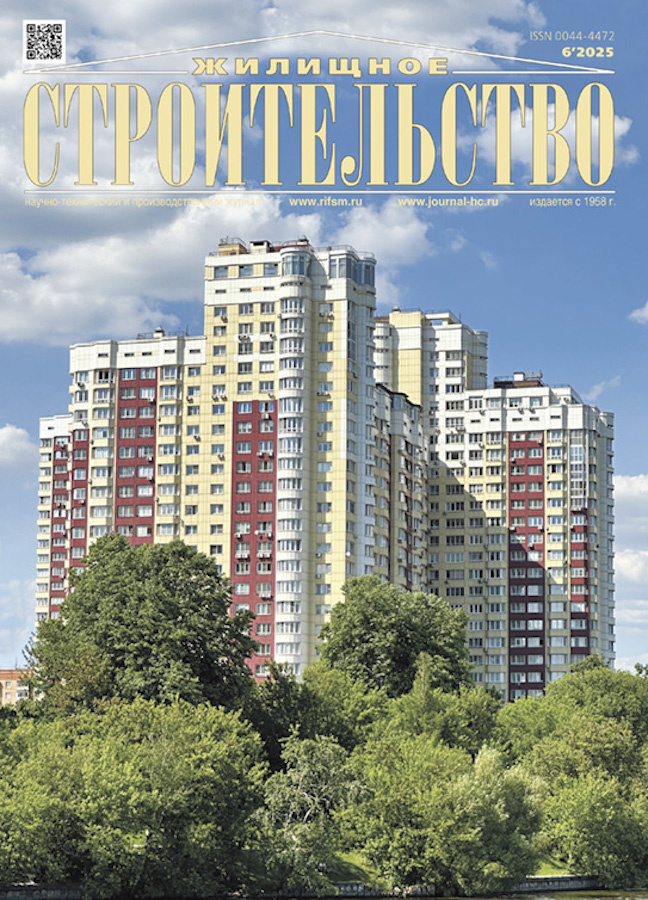Лабораторные исследования сверхвысокой звукоизоляции ограждений
- Авторы: Гребнев П.А.1, Монич Д.В.1
-
Учреждения:
- Нижегородский государственный архитектурно-строительный университет
- Выпуск: № 6 (2025)
- Страницы: 17-24
- Раздел: СТАТЬИ
- URL: https://archivog.com/0044-4472/article/view/688276
- DOI: https://doi.org/10.31659/0044-4472-2025-6-17-24
- ID: 688276
Цитировать
Аннотация
В современной практике строительства стали активно применяться ограждающие конструкции, обладающие высокими и сверхвысокими звукоизолирующими характеристиками. Такие конструкции имеют рациональными по критерию звукоизоляции конструктивные решения и способны обеспечить требуемую защиту от шума. Данные конструкции выделены в классы по критерию звукоизоляции «A», «A+», «A++». Оценка собственной звукоизоляции таких ограждений в реверберационных камерах затруднена вследствие ее приближения к предельным значениям для используемых измерительных стендов. Для повышения точности таких исследований предлагается использовать метод акустической интенсиметрии. Приведены результаты экспериментальных исследований конструкций со сверхвысокой звукоизоляцией в комплексе «Большие акустические камеры ННГАСУ» по стандартному методу и интенсиметрическим методом. При экспериментах имитировалась косвенная звукопередача через конструкции стенда за счет создания искусственных путей прохождения звука между реверберационными камерами и генерации шума помехи непосредственно в приемном помещении. Показана сходимость результатов определения звукоизоляции по двум рассматриваемым методам при отсутствии шума помехи. Показано, что интенсиметрический метод позволяет получать достоверные результаты измерения звукоизоляции при наличии шума помехи в камере низкого уровня. Определены уровни шума помехи, при которых может быть получена экспериментальным путем сверхвысокая звукоизоляция конструкций класса «A++» интенсиметрическим методом.
Полный текст
Об авторах
П. А. Гребнев
Нижегородский государственный архитектурно-строительный университет
Автор, ответственный за переписку.
Email: p.grebnev@mail.ru
канд. техн. наук
Россия, 603000, Нижний Новгород, ул. Ильинская, 65Д. В. Монич
Нижегородский государственный архитектурно-строительный университет
Email: dmitriy.monich@mail.ru
д-р техн. наук
Россия, 603000, Нижний Новгород, ул. Ильинская, 65Список литературы
- Гребнев П.А. Типология современных звукоизолирующих ограждающих конструкций зданий // Приволжский научный журнал. 2024. № 3. С. 25–39. EDN: CQYYXD
- Кочкин Н.А., Иванова А.В., Шубин И.Л., Кочкин А.А. Исследование факторов, влияющих на звукоизоляцию существующих ограждений с дополнительной звукоизоляцией на относе с использованием слоистых вибродемпфированных элементов // Строительные материалы. 2024. № 6. С. 40–45. EDN: XFAHAO. https://doi.org/110.31659/0585-430X-2024-825-6-40-45
- Fahy F.J. Sound Intensity. New York: Elsevier Applied Science. 1989. 285 p.
- Bies D.A., Hansen C.H. Engineering Noise Control. New York: Spon Press. 2009. 747 p.
- Lai J. C. S., Qi Dan. Sound transmission loss measurements using the sound intensity technique. Part 1: The effects of reverberation time. Applied Acoustics. 1993. Vol. 40, рр. 311–324. https://doi.org/10.1016/0003-682X(93)90091-J
- Lai J. C. S., Burgess Application of the sound intensity technique to measurement of field sound transmission loss. Applied Acoustics. 1991. Vol. 34, рр. 77–87. https://doi.org/10.1016/0003-682X(91)90023-8
- Цукерников И.Е., Невенчанная Т.О., Тихомиров Л.А., Щурова Н.Е. Измерения звукоизоляции строительных конструкций с помощью интенсиметрии. Сборник трудов XXXIV сессии Российского акустического общества. 2022. С. 519–527. EDN: YXQPGL. https://doi.org/10.34756/GEOS.2021.17.38125
- Цукерников И.Е., Невенчанная Т.О., Щурова Н.Е. Оценка условий измерения при определении звукоизоляции строительных изделий методом интенсиметрии в лабораторных условиях // Noise Theory and Practice. 2024. Т. 10. № 2 (37). С. 7–16. EDN: GKSSRY
- Цукерников И.Е., Щурова Н.Е., Невенчанная Т.О. Оценка критериев годности акустических условий измерений звукоизоляции строительных изделий методом интенсиметрии по ISO 15186-2 в натурных условиях // БСТ: Бюллетень строительной техники. 2024. № 6 (1078). С. 8–12. EDN: ONSUZV
Дополнительные файлы













